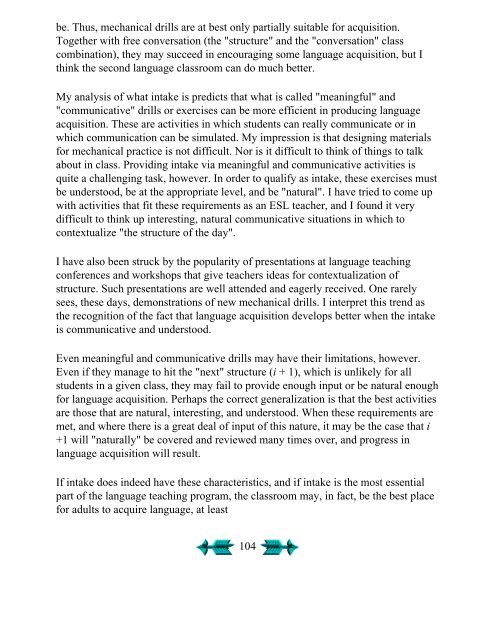Second Language Acquisition and Second ... - Stephen Krashen
Second Language Acquisition and Second ... - Stephen Krashen
Second Language Acquisition and Second ... - Stephen Krashen
You also want an ePaper? Increase the reach of your titles
YUMPU automatically turns print PDFs into web optimized ePapers that Google loves.
e. Thus, mechanical drills are at best only partially suitable for acquisition.<br />
Together with free conversation (the "structure" <strong>and</strong> the "conversation" class<br />
combination), they may succeed in encouraging some language acquisition, but I<br />
think the second language classroom can do much better.<br />
My analysis of what intake is predicts that what is called "meaningful" <strong>and</strong><br />
"communicative" drills or exercises can be more efficient in producing language<br />
acquisition. These are activities in which students can really communicate or in<br />
which communication can be simulated. My impression is that designing materials<br />
for mechanical practice is not difficult. Nor is it difficult to think of things to talk<br />
about in class. Providing intake via meaningful <strong>and</strong> communicative activities is<br />
quite a challenging task, however. In order to qualify as intake, these exercises must<br />
be understood, be at the appropriate level, <strong>and</strong> be "natural". I have tried to come up<br />
with activities that fit these requirements as an ESL teacher, <strong>and</strong> I found it very<br />
difficult to think up interesting, natural communicative situations in which to<br />
contextualize "the structure of the day".<br />
I have also been struck by the popularity of presentations at language teaching<br />
conferences <strong>and</strong> workshops that give teachers ideas for contextualization of<br />
structure. Such presentations are well attended <strong>and</strong> eagerly received. One rarely<br />
sees, these days, demonstrations of new mechanical drills. I interpret this trend as<br />
the recognition of the fact that language acquisition develops better when the intake<br />
is communicative <strong>and</strong> understood.<br />
Even meaningful <strong>and</strong> communicative drills may have their limitations, however.<br />
Even if they manage to hit the "next" structure (i + 1), which is unlikely for all<br />
students in a given class, they may fail to provide enough input or be natural enough<br />
for language acquisition. Perhaps the correct generalization is that the best activities<br />
are those that are natural, interesting, <strong>and</strong> understood. When these requirements are<br />
met, <strong>and</strong> where there is a great deal of input of this nature, it may be the case that i<br />
+1 will "naturally" be covered <strong>and</strong> reviewed many times over, <strong>and</strong> progress in<br />
language acquisition will result.<br />
If intake does indeed have these characteristics, <strong>and</strong> if intake is the most essential<br />
part of the language teaching program, the classroom may, in fact, be the best place<br />
for adults to acquire language, at least<br />
104











